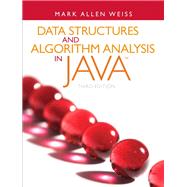
Note: Supplemental materials are not guaranteed with Rental or Used book purchases.
Purchase Benefits
Looking to rent a book? Rent Data Structures and Algorithm Analysis in Java [ISBN: 9780132576277] for the semester, quarter, and short term or search our site for other textbooks by Weiss, Mark A.. Renting a textbook can save you up to 90% from the cost of buying.
Mark Allen Weiss is Professor and Associate Director for the School of Computing and Information Sciences at Florida International University. He is also currently serving as both Director of Undergraduate Studies and Director of Graduate Studies. He received his Bachelor’s Degree in Electrical Engineering from the Cooper Union in 1983, and his Ph.D. in Computer Science from Princeton University in 1987, working under Bob Sedgewick. He has been at FIU since 1987 and was promoted to Professor in 1996. His interests include data structures, algorithms, and education. He is most well-known for his highly-acclaimed Data Structures textbooks, which have been used for a generation by roughly a million students.
Professor Weiss is the author of numerous publications in top-rated journals and was recipient of the University’s Excellence in Research Award in 1994. In 1996 at FIU he was the first in the world to teach Data Structures using the Java programming language, which is now the de facto standard. From 1997-2004 he served as a member of the Advanced Placement Computer Science Development Committee, chairing the committee from 2000-2004. The committee designed the curriculum and wrote the AP exams that were taken by 20,000 high school students annually.
In addition to his Research Award in 1994, Professor Weiss is also the recipient of the University’s Excellence in Teaching Award in 1999 and the School of Computing and Information Science Excellence in Teaching Award (2005) and Excellence in Service Award (2007).
The New copy of this book will include any supplemental materials advertised. Please check the title of the book to determine if it should include any access cards, study guides, lab manuals, CDs, etc.
The Used, Rental and eBook copies of this book are not guaranteed to include any supplemental materials. Typically, only the book itself is included. This is true even if the title states it includes any access cards, study guides, lab manuals, CDs, etc.